3-Bed Configurations
1/26
There's no tags or description
Looks like no tags are added yet.
Name | Mastery | Learn | Test | Matching | Spaced |
|---|
No study sessions yet.
27 Terms
What causes a bed to erode or deposit? What is the relationship between flow velocity and erosion or deposition of the bed?
Not controlled by absolute velocity - controlled by the rate of change of sediment load through time and space.
Turbulence results in variation in bed shear stress.
Sediment transport rate increases with increasing bed shear stress, and increasing flow velocity.
What is the Exner equation?
How much coming out - how much coming in
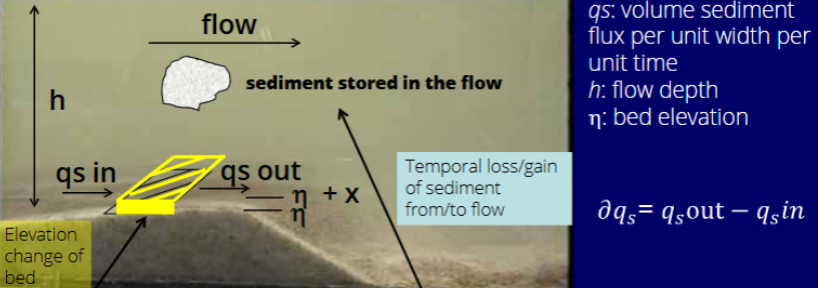
What aspect of a flow does flow capacity describe? What about flow competence?
✅ Flow capacity → how much sediment (total load) a flow can carry.
✅ Flow competence → the largest particle size a flow can move.
What is the difference between a unidirectional, oscillatory and multidirectional flow?
✅ Unidirectional flow: moves mainly one way (e.g. rivers).
✅ Oscillatory flow: back-and-forth motion (e.g. waves).
✅ Multidirectional flow: moves in several directions (e.g. tidal or delta currents).
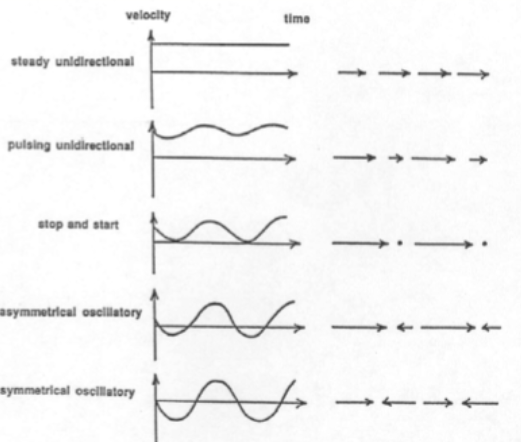
Why do smaller grains require more shear stress to get them off the bed?
Because smaller grains are more affected by cohesion and surface forces (like electrostatic or van der Waals forces).
Cohesion makes particle stick together, resisting erosion.
Generally, larger grains require more shear stress to move.
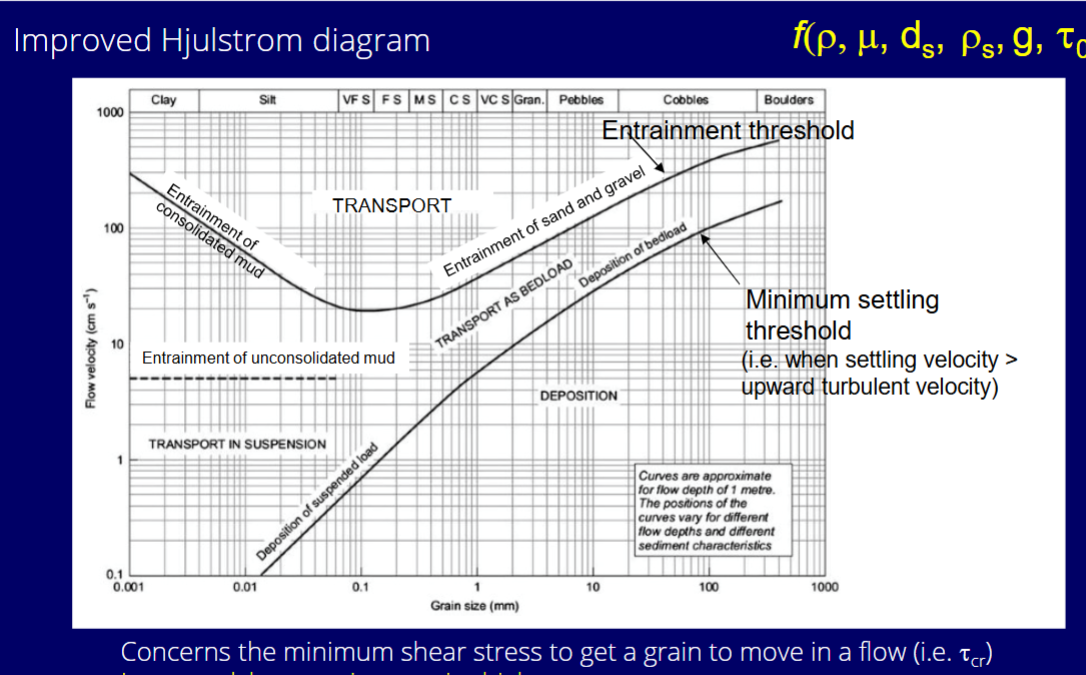
What types of movement do we get on grains through a fluid?
T,0 > T cr = rolling
T,0 >> T cr = saltation
T,0 >>> T cr = suspension
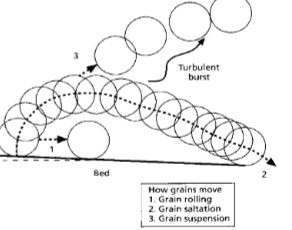
What is a bedform? Give examples.
Bedform: sediment transported over a bed by a turbulent flow is moulded into bedforms
e.g. ripples on shoreline, wind ripples in desert, dunes on a river bed
'“individual topographic elements, produced by the accumulation of mobile sediment grains into some shape or morphological element due to interaction with fluid current
What is the difference between a bed configuration, a bedform and a sedimentary structure?
Bed configuration - overall bed geometry that exists in response to flow and is composed of both bedforms and sedimentary structures.
Bedform - sediment transported over a bed by a turbulent flow, accumulation of mobile sediment grains into some shape due to interaction with fluid current.
Sedimentary structures - record of deposition in the presence of bedforms
What variables are important in determining what bedform will form? Which are most important?
direction of flow (unidirectional, oscillatory, combined
duration of flow
strength of flow (velocity and shear stress)
grain diameter and density of sediment
nature of turbulent boundary (hydraulically smooth or rough)
What things can you adjust on a flume tank?
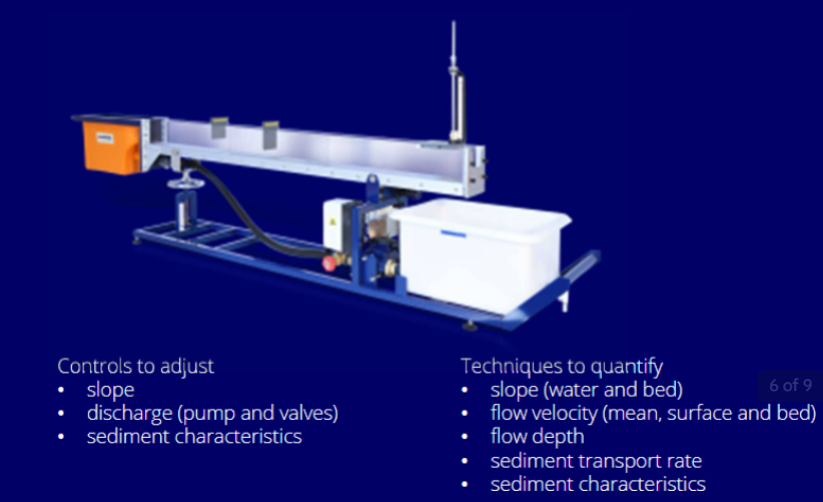
What sequence of bedforms will develop in fine-medium sands as the flow velocity increases? (assume constant flow depth)
Finer sands form ripples, coarser sands just form lower plane bed.
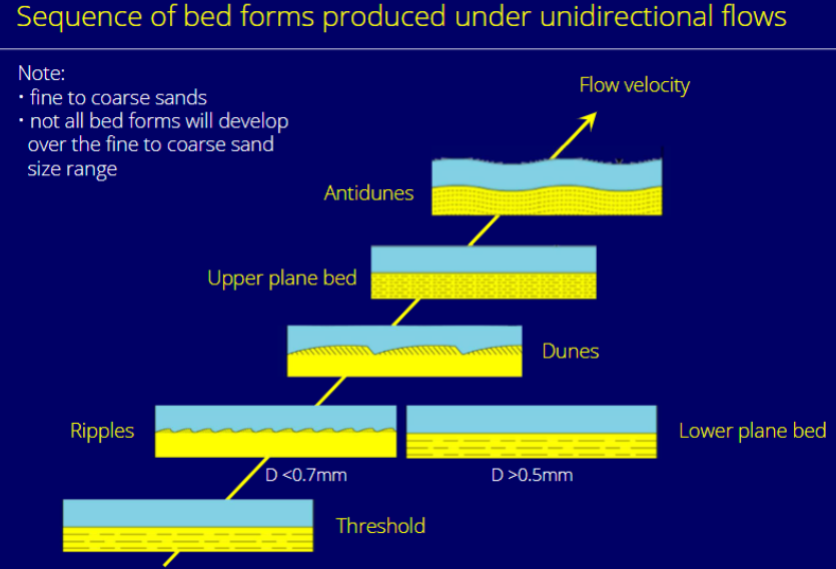
Water surface looks smooth and glassy but what two ways could you determine whether the flow structure is laminar or turbulent?
Dropping in some red dye - does it trace out a line or is it mixed?
Calculate Reynolds number.
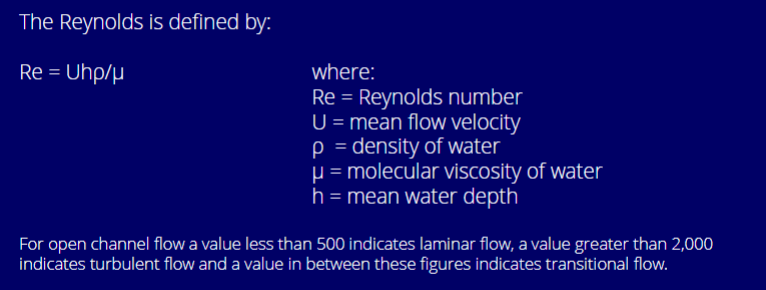
What is the dominant mode of sediment transport (e.g., rolling and sliding, saltation, suspended load) for each type of bedform? What is the relationship between the mode of sediment transport and velocity of the flow?
Threshold/lower plane bed - rolling and sliding
Ripples - saltation, grains hopping along bed (some rolling)
Dunes - saltation
Upper plane bed - sheet flow, some in suspension
Antidunes - suspension
How do you calculate the critical shear stress?
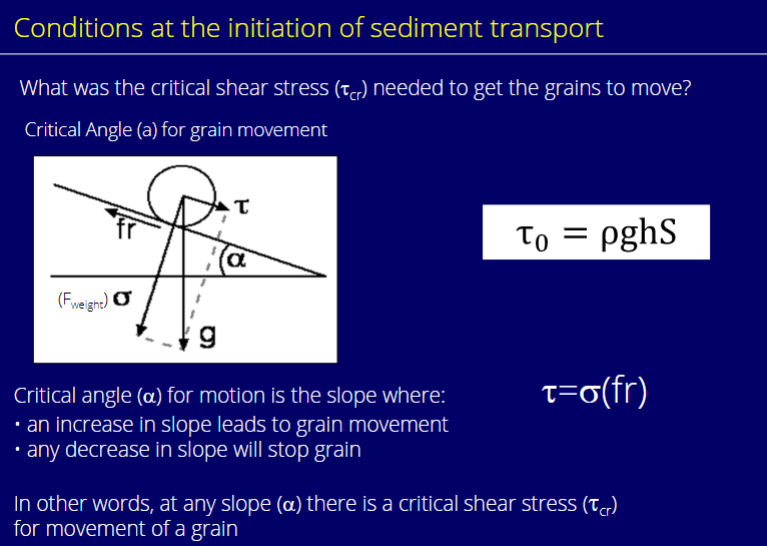
What is the relationship between the nature of the turbulent boundary (hydraulically rough or smooth), grain size and the bedform created?

What bedform will develop just after the initiation of motion in sands >0.5mm in diameter?
Lower bed plane
What bedform will not develop just after the initiation of motion if sands are >0.5-0.7mm in diameter?
Ripples
Over which grain-size ranges do ripples form?
<0.7mm = ripples
Ripples don’t grow into dunes - transition is abrupt.
Dunes don’t form in sediment <0.2mm
What is the relationship between ripple geometry and grain size? Why do you think this might be?
Ripple wavelength and height increase with grain size—coarser grains form larger, taller ripples
for up to 0.5-0.7mm, when ripples no longer form
What is the relationship between flow depth and ripple geometry (wavelength and height)?
Ripple wavelength and height increase with flow depth—deeper flow produces larger, taller ripples.
Up to point where flow is strong enough to flatten bed.
Key important facts:
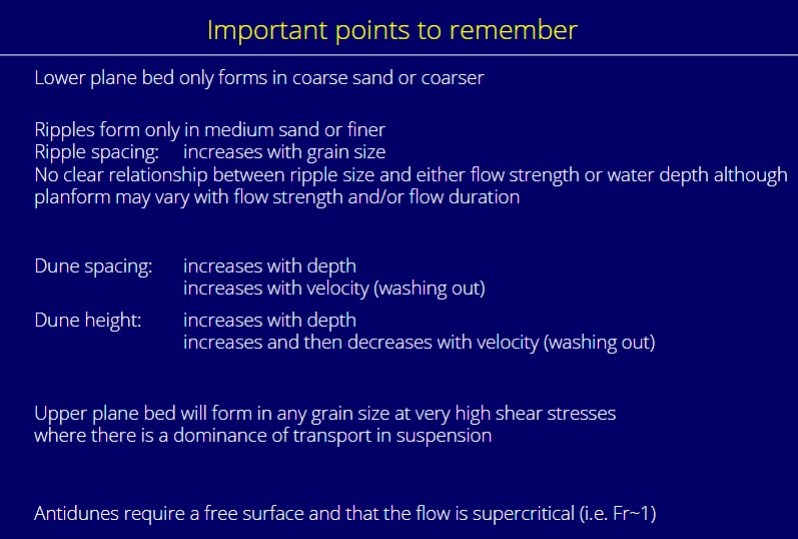
How does one distinguish between 2D ripples and 3D ripples?
2D vs 3D ripples:
2D: Crests straight and parallel to flow.
3D: Crests sinuous or curved, showing multidirectional flow effects.
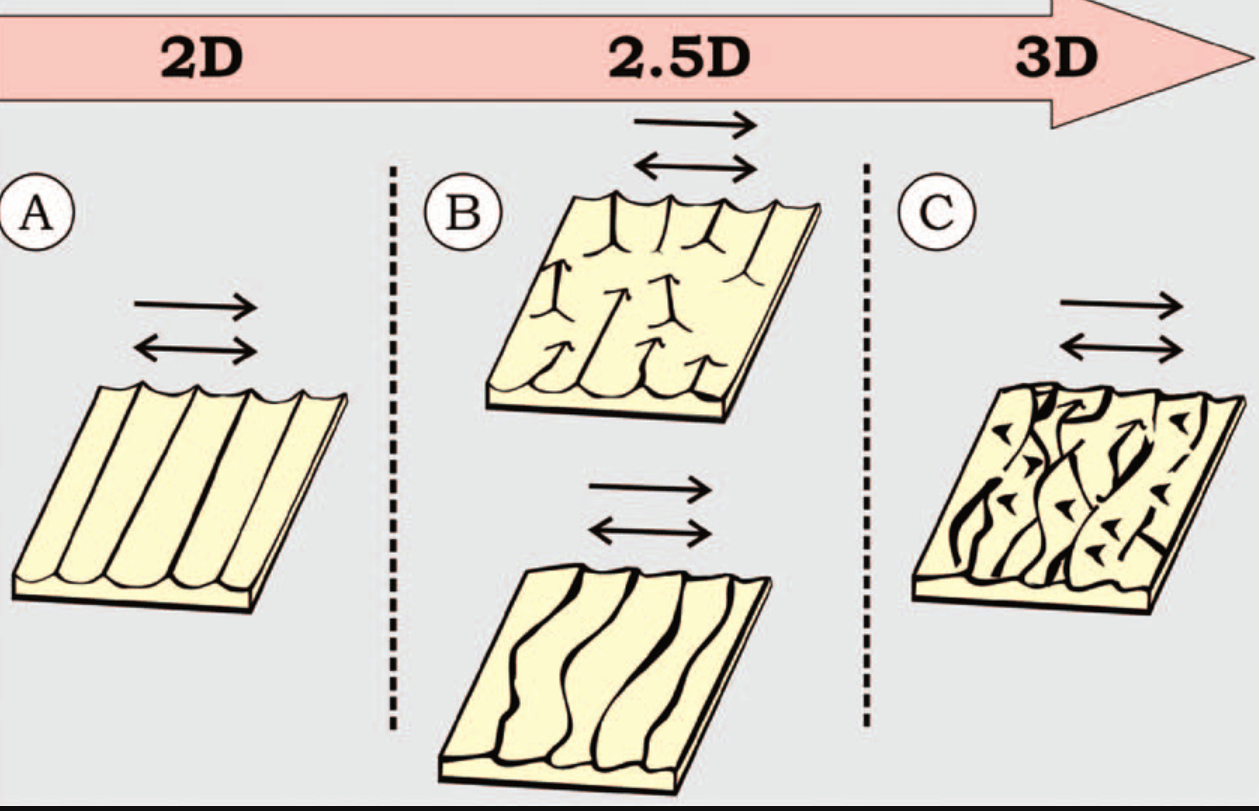
What is the relationship between ripple geometry and flow strength and flow duration?
Stronger or longer flow → larger wavelength and height.
What might you interpret if you see 2D ripples on a bedding plane in the rock record?
flow was short-lived
ripples formed in presence of waves
indicates unidirectional, steady flow at the time of deposition
Recap of bedforms formed:
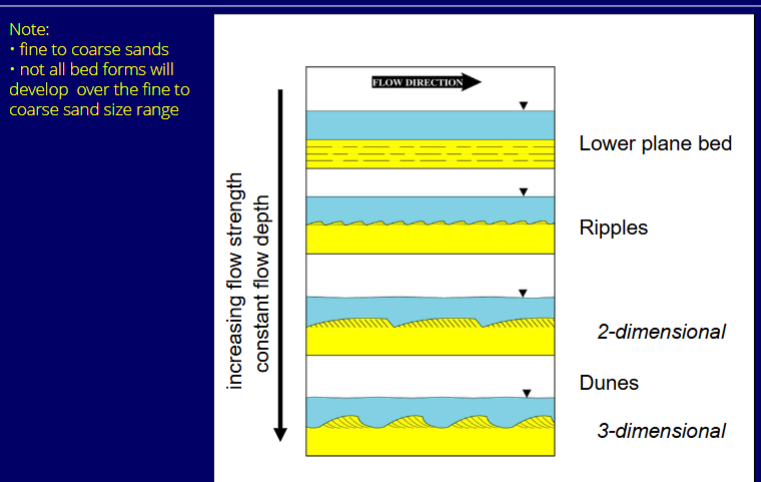
What happens when there is a further increase in flow strength?
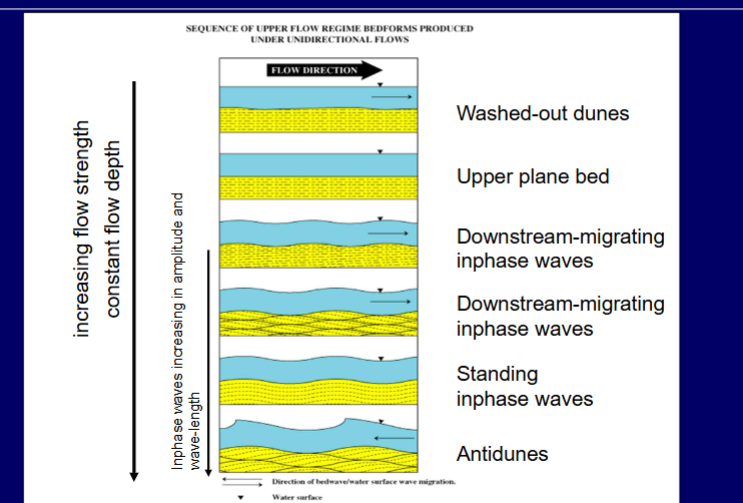
What is meant by entrainment threshold and settling threshold?
Entrainment threshold = the minimum flow velocity needed to lift a grain off the bed and start it moving.
Settling threshold = the velocity below which a grain can settle and stay deposited